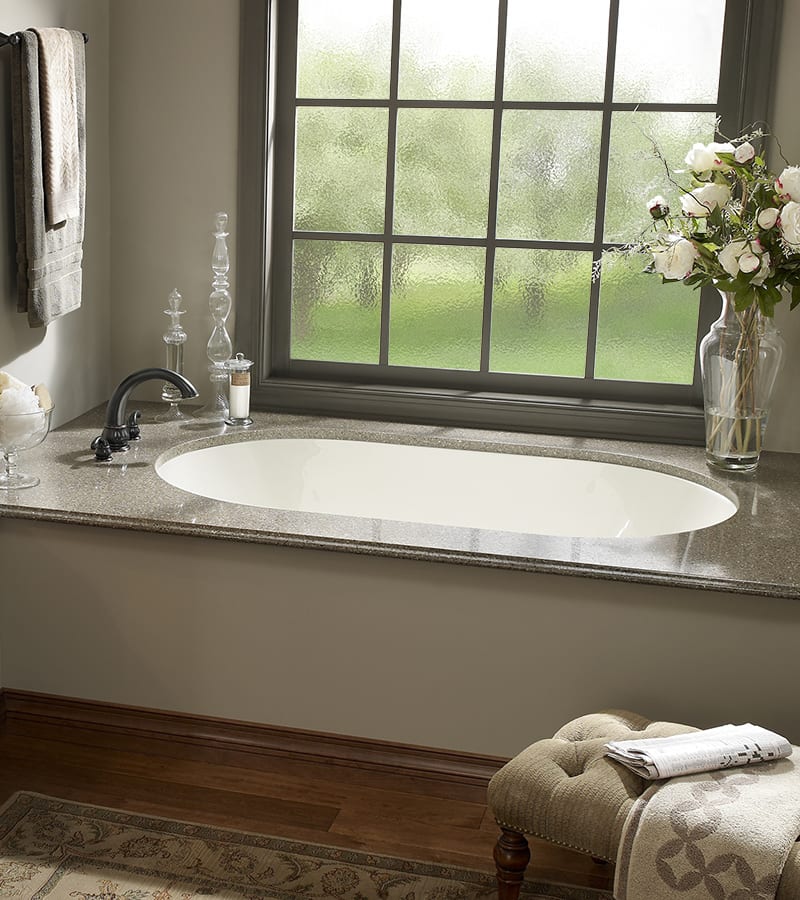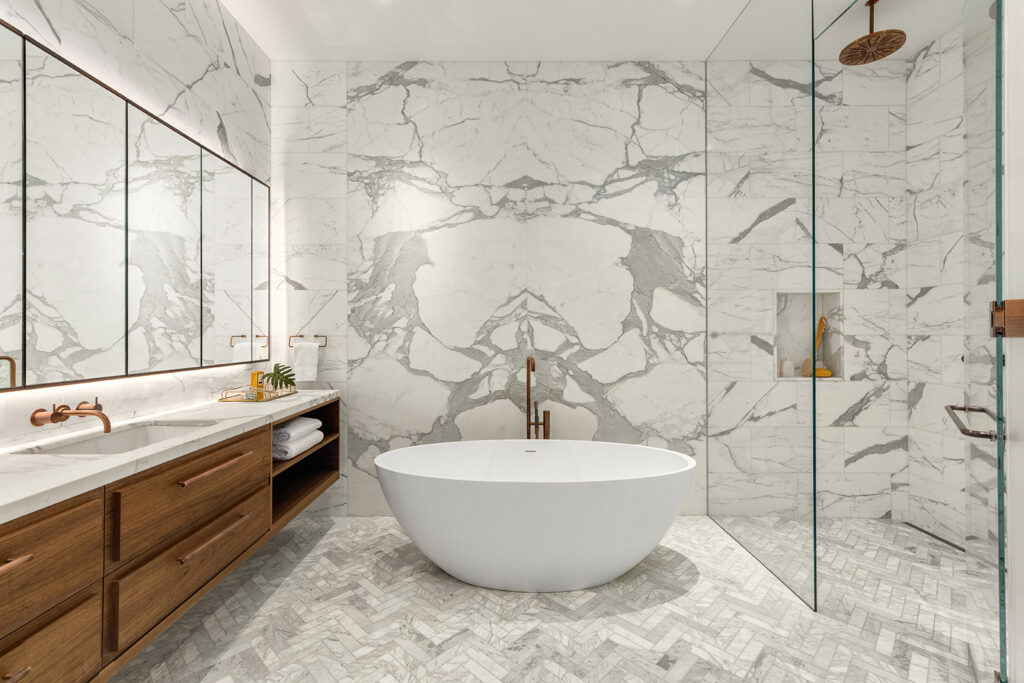
One-Piece vs Two Piece Toilet – Pros and Cons- 2025 Expert Guide
When upgrading your bathroom, one of the most important—and often overlooked—decisions is choosing between a one-piece or two-piece toilet. While
Shopping for the perfect bathtub can be a hassle and with so many options on the market, it’s hard to find out which is the right fit for you. For those looking for something different than the standard bathtub, there’s the undermount bathtub. A bathtub that is non-intrusive, blending seamlessly with your bathroom while still giving you the benefits of having a nice surprise for your guests. Today, we will be discussing if an undermount bathtub is the right fit for your home.
An undermount bathtub is a bathtub that is installed underneath a rim, meaning that the surrounding deck or area is covered so that the bathtub itself is supported by the floor structure underneath. This is in fact, very similar to a drop-in bathtub except that a drop-in is placed above the rim, whereas an undermount is installed underneath it.
An undermount and drop-in bathtub are actually very similar if not identical. The bathtubs themselves are identical in design, the only difference being their method of installation. Undermount bathtubs are installed beneath a rim so that the bathtub’s weight is distributed between the floor structure and the rim. Drop-in bathtubs are installed above the rim, placing much of their weight on the rim itself. Lastly, is their appearance, with drop-in bathtubs usually containing a raised lip as they are installed above the rim, making their sides plainly visible whereas undermount bathtubs are finished on all sides so their edges are hidden from view. Aside from that, these two bathtubs are nearly identical in terms of price and size.
Undermount bathtubs offer an elegant, smooth aesthetic, which looks really well in all kinds of bathrooms. Also, undermount tubs provide design flexibility with numerous shapes and upgrades, which can be interesting for those homeowners who would like to customize their bathtubs to fit their needs and preferences. Not to mention that this also makes it a great choice compared to other bathtub types as you’ll be able to find a model for any amount of space you might have. Lastly, one of the great benefits is that undermount tubs allow for deep, relaxing soaks.
When it comes to cons of undermount tubs, keep in mind that they can be difficult to get in and get out, so if accessibility is important for you, this type of tub might not be the right choice. Also, if your undermount tub is made from marble or granite, it will probably require more floor support.
Undermount bathtubs come in a variety of styles to suit almost any style of home. Whether you have a large bathroom or a more modest offering, there is enough variety in terms of style to cater to almost any bathroom. The three most prevalent styles are Standard, oval and corner.
This is an undermount bathtub that is placed in an ingress before an outer rim is placed above it, hiding the edges of the bathtub itself. This style will mesh typically with the standard bathtub sizes, providing a longer bathtub, with a raised platform or rim generally taking up an equal amount of space as a normal drop-in bathtub.
These tubs are for those that prefer a longer, more relaxing soak in a small area as these bathtubs are generally rounder, providing a wider area to lounge while still being small enough when compared to the traditional bathtub. These are typically made into hot tubs or jacuzzis as their shape is countered to allow a person to bathe more comfortably than other designs.
Cortner bathtubs are quite similar to oval bathtubs as they are both round in shape, but where oval bathtubs are made to be much more comfortable to sit in, a corner bathtub is designed to save space. Whereas an oval bathtub is round, a corner bathtub is generally triangular in shape, giving you a more compact bathing area without losing much in terms of comfort.
Undermount bathtubs come in a wide variety of materials ranging from lightweight materials such as acrylic to heavier set options such as cast iron. The quality of your bathtub will ultimately depend on the materials used, but keep in mind that some material will be heavier than others, making them much more difficult to accommodate, especially in smaller bathrooms. With undermount bathtubs in particular, bear in mind that the rim or surrounding tile will be more visible than the bathtub itself, so many homeowners choose a cheaper material for the bathtub while spending more money for a more aesthetically pleasing surround instead.
Cheap, lightweight, easy to install and simple to maintain. Fiberglass is a desirable material since it lends much flexibility in terms of installation compared to other materials on the market, making it suitable for all bathroom sizes. That being said, it’s flexibility comes at a heavy cost as it is perhaps the least durable of all other materials and it is porous, meaning it will not retain heat well and it will eventually absorb enough water to crack and become unstable.
A classic material, cast iron is one of the most durable materials on the market, while also being one of the heaviest materials on the market as well. It is constructed from molded iron which is then coated with porcelain enamel. It has excellent heat retention and is incredibly durable, but as stated before, the trade-off is that the material is very heavy. Additional floor supports are recommended if you choose to buy a cast iron bathtub.
A good compromise between the high and low end of the material spectrum, acrylic offers a material that blends the versatility of fiberglass while still being much more durable for a relatively low cost. It is also non-porous, meaning it has better heat retention and will certainly last much longer than fiberglass.

Discussing the cost of an undermount bathtub is a bit different than comparing the price of other bathtubs on the market, and that is because the bathtub equates about half the price you are expected to pay. That is because an undermount bathtub requires a platform or a raised area to install, requiring a fair bit of tile which will end up much more expensive than simply buying a drop-in bathtub. That being said, the average cost of an undermount tub ranges from $200-2000. Small and medium bathtubs will range anywhere from $200-1200, respectively, with larger bathtubs filling the rest of the spectrum between 1200-2000. For the tile installation or platform modifications, you are looking to spend an additional $700-1200, depending on the material used and the size of the platform itself.
| Undermount tub | Size |
| Small-sized undermount tubs | 30×45 |
| Medium-sized undermount tubs | 50×30 |
| Large-sized undermount tubs | 72×30 |
Equally important to finding the right style or material is of course, size. Bathtubs come in a wide variety of sizes to fit just about any bathroom, so it’s best to determine what your bathroom needs before purchasing. The common sizes of undermount bathtubs are 30×45, 60×30, 54 inches, 60 inches, and 72×32. 30×45 is considered the smallest size, with 30×72 being slightly larger. Medium sized would be 50×30, to 60×30, with the largest sizes ended at 72 inches long with a width of 30 inches.
Installing an undermount bathtub or any bathtub is a simple job, but not an easy one. Like everything else, if you are unsure of any step, consult a professional before proceeding to DIY this project.
For those looking for a non-intrusive and stylish option, an undermount bathtub is a great choice, providing a bathtub that is easy to install and doesn’t steal the show from the grandeur of your bathroom.

Eric is the founder and president of Badeloft USA. He has been the president of Badeloft’s US division for over ten years and oversees all marketing and branding aspects of Badeloftusa.com.
His expertise lies in small business development, sales, and home and bathroom industry trends and information.
Contact us with any business related inquiries.

Free material samples and tub templates

When upgrading your bathroom, one of the most important—and often overlooked—decisions is choosing between a one-piece or two-piece toilet. While

Small details, including what you place on the floor, can make a big difference when setting up or upgrading your

Plumbing traps may seem like small components, but they are critical in keeping your home safe and odor-free. Two of
When shopping for new bath linens, the difference between a bath towel and a bath sheet can feel subtle, but
Request your free material sample below. By submitting, you agree to receive occasional product updates and offers from Badeloft. Unsubscribe anytime.
"*" indicates required fields
"*" indicates required fields
"*" indicates required fields